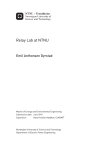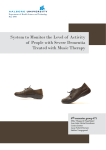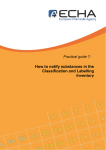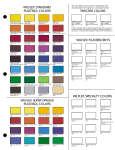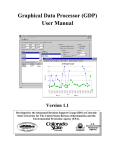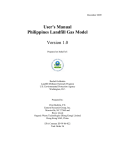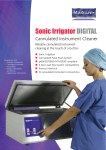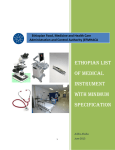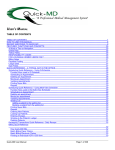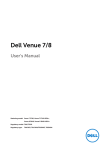Download epa risk management program rule to impact distributors
Transcript
EPA RISK MANAGEMENT PROGRAM RULE TO IMPACT DISTRIBUTORS AND MANUFACTURERS I. Introduction Under an EPA rule designed to prevent chemical accidents, certain distributors, formulators and manufacturers of chemical cleaning products will have to implement a risk management program and file a risk management plan (RMP) with EPA by June 21, 1999. Facilities that “handle, produce, or store” any of the listed 77 toxic substances or 63 flammable chemicals above the established threshold quantities are likely to be subject to the risk management program rule. (You must take into consideration the presence of these substances when present as pure substances or in mixtures above 1% concentration unless there is a listed concentration for the substance.) Some of the listed toxic chemicals subject to the rule and their respective threshold quantities are set forth below: · anhydrous ammonia (10,000 lbs.) · chlorine (2,500 lbs.) · hydrochloric acid (concentration of 37% or greater - 15,000 lbs.) · hydrofluoric acid (concentration of 50% or greater - 1,000 lbs.) · nitric acid (concentration of 80% or greater - 15,000 lbs.) · propylene oxide (10,000 lbs.) Other listed toxic chemicals have threshold quantity values ranging from 1,000 lbs. to 20,000 lbs. Flammable chemicals such as butane, 1, 3-Butadiene, isobutane, isopropyl chloride, and propane each have a threshold quantity of 10,000 lbs. (Please note, the use of propane as a fuel is covered by the rule.) A complete copy of the chemicals subject to the Risk Management Program Rule is attached as Appendix A. The rule also covers flammable mixtures that include any of the listed flammable chemicals if the mixture meets the criteria for the National Fire Protection Association’s (NFPA) 4 rating (i.e., flashpoint below 73°F and boiling point below 100°F). II. Overview The Risk Management Program Rule (also known as Clean Air Act section 112(r), the RMP rule or Part 68) is designed to prevent serious chemical accidents that could affect public health and the environment and to improve the response to any accidents that do occur. The rule requires covered facilities to develop and to implement an integrated system to identify hazards and manage risks. If you are subject to this rule, you must analyze worst-case releases, 1 document a five year history of serious accidents, coordinate with local emergency responders, and file a risk management plan with EPA. If your worst-case release could affect the public, you also must analyze more realistic alternative scenarios and develop and implement a prevention program that includes, among other things, identification of hazards, written operating procedures, training, maintenance, and accident investigation. If your employees respond to accidental releases, you must implement an emergency response program. The risk management plan you submit to EPA will summarize your program and will have to be made available to the public. III. How to Determine if you are Subject to the RMP Rule The purpose of this section is to describe the conditions under which your facility would be subject to the Risk Management Program Rule. In brief, you are covered by the RMP rule if you are: · The owner or operator of a “stationary source” (i.e., a manufacturing plant, a warehouse) · That has more than a threshold quantity · Of a regulated substance · In a “process.” A. Stationary Source. The regulation defines the term “stationary sources” as “any buildings, structures, equipment, installations, or substance emitting stationary activities which belong to the same industrial group, which are located on one or more contiguous properties, which are under the control of the same person (or persons under common control), and from which an accidental release may occur.” As a practical matter, the term “stationary source” includes, but is not limited to, the following: a single distribution warehouse; two distribution warehouses located on contiguous properties; a facility that formulates cleaning products; and two formulating facilities located on the same property. Please review the material below for a discussion of key terms. 1. Same Industrial Group. Operations at a site that belong to the same three digit North American Industry Classification System (NAICS) code (which has replaced the old two digit SIC codes) belong to the “same industrial group.” In addition, where one or more operations at the site serve primarily as support facilities for the main operation at the same site, the supporting operations are part of the “same industrial group” as the main operation. For example, if you manufacture chemical products (NAICS 325) and operate a waste treatment facility (NAICS 562) that handles wastes generated by your chemical operations, the waste operation would be considered a support operation. 2. Contiguous Property. Property that is adjoining is considered “contiguous property.” Public rights-of-way (e.g., railroads, highways) do not prevent property from being considered contiguous. 2 3. Control of the Same Person. “Control of the same person” refers to corporate control, not site management. For example, if two divisions of a corporation operate at the same site (even if operation is managed separately) they will count as one source provided the other criteria are met because they are under control of the same company. 4. Transportation Containers. Transportation containers used for storage not incident to transportation and transportation containers connected to equipment at a stationary source are considered part of the stationary source. Also, transportation containers that have been unhooked from the motive power that delivered them to the side (i.e., truck or locomotive) and left on site for short-term or long-term storage are part of the stationary source. B. Regulated Substances and Thresholds. The list of substances regulated under the Risk Management Program Rule is in Appendix A. Check the list carefully. If you do not have any of these substances (either as pure substances or in mixtures above 1% concentration) or do not have them above their listed threshold quantities, you are not covered under the RMP rule. The list includes 77 chemicals that were listed because they are acutely toxic; they can cause serious health effects or death from short-term exposures. The list also covers 63 flammable gases and highly volatile flammable liquids. The flammable chemicals have the potential to form vapor clouds and explode or burn if released. The rule also covers flammable mixtures that include any of the listed flammables if the mixture meets the criteria for the National Fire Protection Association’s (NFPA) 4 rating (i.e., flash point below 73°F and boiling point below 100°F). Please review the sections below titled What is a Process and Threshold Quantity in a Process. These sections are important in determining whether you have any of the regulated substances present in a process in excess of a threshold quantity. If you do, your facility is regulated under RMP. Conversely, if you do not have such substances present in a process in excess of threshold quantities, you are not subject to the rule. C. What is A Process. If you have more than a threshold quantity of a regulated substance in a process, you are covered by the RMP rule. Therefore, the concept of “process” is key to whether you are subject to this rule. Process is defined in 40 CFR §68.3 as: “Any activity involving a regulated substance, including any use, storage, manufacturing, handling, or on-site movement of such substances, or combination of these activities. For the purposes of this definition, any group of vessels that are interconnected, or separate vessels that are located such that a regulated substance could be involved in a potential release, shall be considered a single process.” “Vessel” in §68.3 means any reactor, tank, drum, barrel, cylinder, vat, kettle, boiler, pipe, hose, or other container. This term includes 55 gallon drums as well as smaller product containers. A “process” can be as simple as a single storage vessel (i.e., in the case of a formulator who stores raw materials on site) or a group of drums, cylinders or other containers stored in one 3 location (i.e., in the case of a distributor warehouse). Of course, a process can also be complicated such as a system of interconnected reactor vessels, distillation columns, receivers, pumps, piping and storage vessels. To better illustrate the rule’s applicability, it is important to review the following potential scenarios. 1. Single Vessels. If you store a regulated substance in a vessel in quantities above the threshold quantity you are covered (i.e., a storage tank for raw materials). 2. Interconnected Vessels. In general, if you have two or more vessels containing a regulated substance that are connected through piping or hoses for the transfer of the regulated substance, you must consider the total quantity of a regulated substance in all the connected vessels and piping when determining if you have a threshold quantity in a process. If the vessels are connected for transfer of the substance using hoses that are sometimes disconnected, you still have to consider the contents of the vessels as one process, because if one vessel were to rupture while the hose was attached or the hose were to break during the transfer, both tanks could be affected. Therefore, you must count the quantities in both tanks and in any connecting piping or hoses. You cannot consider the presence of automatic shutoff valves or other devices that can limit flow, because these are assumed to fail for the purpose of determining the total quantity in a process. Such a situation is common in facilities that formulate or blend chemical cleaning products. 3. Co-Location. This third situation is relevant to warehousing operations such as those used by distributors of cleaning products as well as those operated by formulating facilities that may store raw materials or end use products on site. In regard to this third possibility, you must consider whether you have separate vessels (i.e., containers, drums, cylinders, etc.) that contain the same regulated substance that are located such that they could be involved in a single release. If so, you must add together the total quantity in all such vessels to determine if you have more than a threshold quantity. This possibility will be particularly important if you store a regulated substance in cylinders or barrels or other containers in a warehouse or outside in a rack. In some cases, you may have multiple vessels or containers that are in the same building or room. For each of these cases, you should ask yourself: Could a release from one of the containers lead to a release from the other? For example, if a cylinder of propane were to rupture and burn, would the fire spread to other propane cylinders? Could an event external to the containers, such as a fire or explosion or collapse or collision (e.g., a vehicle collides with several stored containers), have the potential to release the regulated substance from multiple containers? You must determine whether there is a credible scenario that could lead to a release of a threshold quantity. If such a scenario exists then the co-location of such containers or 4 other vessels would be considered a single process subject to the requirements of the RMP rule. For flammables, you should consider the distance between vessels in order to determine if they are part of a single process. If a fire could spread from one vessel to others or an explosion could rupture multiple vessels, you must count all of them. For toxics, a release from a single vessel will not normally lead to a release from others unless the vessel fails catastrophically and explodes, sending metal fragments into other vessels. Co-located vessels containing toxic substances, however, may well be involved in a release caused by a fire or explosion that occurs from another source. The definition of process is predicated on the assumption that explosion will take place. In addition, a collapse of storage racks could lead to multiple vessels breaking open. If the vessels are separated by fire walls or barricades that will contain the blast waves from explosions of the substances, you will not need to count the separated vessels, but you would count any that are in the same room. You may not dismiss the possibility of a fire spreading based on an assumption that your fire brigade will be able to prevent any spread. You should ask yourself how far the fire would spread if the worst happens – the fire brigade is slow to arrive, the water supply fails, or the local fire department decides it is safer to let the fire burn itself out. If you have separate vessels containing a regulated substance that could be affected by the same accident, you should count them as a single process. 4. Processes with Multiple Chemicals. When you are determining whether you have a covered process, you should not limit your consideration to vessels, that have the same regulated substance. A covered process includes any vessels that altogether hold more than a threshold quantity of regulated substances and that are interconnected or co-located. Therefore, if you have four storage or rector vessels holding four different regulated substances above their individual thresholds and they are located close enough to be involved in a single event, they are considered a single process. One implication of this approach is that if you have two vessels, each containing slightly less than a threshold quantity of the same regulated substance and located a considerable distance apart, and you have other storage or process vessels in between with other regulated substances above their thresholds, the two vessels with the first substances may be considered to be part of a larger process involving the other intervening vessels and other regulated substances, based on co-location. D. Threshold Quantity in a Process. The threshold quantity for each regulated substance is set forth in the list of regulated substances which is attached as Appendix A. You should determine whether the maximum quantity of each substance in a process is greater than the threshold quantity listed. If it is, you must comply with this rule for that process. (Please note, even if you are not covered by this rule, you may still be subject to reporting requirements under the Emergency Planning and Community Right-to-Know Act.) 5 1. Aggregation of Substances. Under the RMP rule, a listed toxic substance is never aggregated with a different toxic substance to determine whether a threshold quantity is present. If your “process” consists of co-located vessels/containers with different toxic substances, you must determine whether each substance exceeds its threshold quantity for its respective vessel/container. A flammable substance in one vessel/container is never aggregated with a different flammable substance in another vessel/container to determine whether a threshold quantity is present. However, if a flammable mixture meets the criteria for NFPA-4 (i.e., flash point below 73°F and boiling point below 100°F) and contains different regulated flammables, it is the mixture, not the individual substances, that is considered in determining if a threshold quantity is present. 2. Quantity in a Single Vessel. To determine if you have the threshold quantity of a regulated substance in a vessel involved in a single process (i.e., a storage tank) you need to consider the maximum quantity in that vessel “at any one time.” You do not need to consider the vessel’s maximum capacity if you never fill it to that level. Base your decision on the actual maximum quantity that you may have in the vessel. Your maximum quantity may be more than your normal operating maximum quantity; for example, if you may use a vessel for emergency storage, the maximum quantity should be based on the quantity that might be stored. “At any one time” means you need to consider the largest quantity that you ever have in the vessel for purposes of your calculations. For example, if you fill a storage tank with 50,000 lbs. and immediately begin using the substance thereby depleting its contents, your maximum quantity is 50,000lbs. Furthermore, if you fill the vessel four times year, your maximum is still 50,000 lbs. We do not consider the aggregate quantity over the course of a year or other time period. The RMP rule only is concerned about the maximum quantity you could release in a single event. 3. Quantity in a Pipeline. The maximum quantity in a pipeline will generally be the capacity of the pipeline (volume). In most cases, pipeline quantity will be calculated and added to the interconnected vessels. 4. Interconnected/Co-Located Vessels. If your process consists of two or more interconnected vessels and the connecting pipes or hoses. The maximum for each individual vessel and pipe is added together to determine the maximum for the process. If you have determined that you must consider co-located vessels as one process, you must determine the maximum quantity for each vessel and sum up the quantities of all such vessels. 5. Quantity of a Substance in a Mixture. In calculating the total quantity of a regulated substance in mixture you must adhere to the following procedures: 6 a) Toxic Substances with a Listed Concentration. Under the RMP rule, there are four toxic substances that have listed concentrations in the rule: hydrochloric acid - 37% or greater; hydrofluoric acid - 50% or greater; nitric acid - 80% or greater; and ammonia 20% or greater. If you have these substances in solution and their concentration is less than the listed concentration, you do not need to consider those substances in your calculations. It is as if they did not exist for purposes of the RMP rule. If you have one of these four above their listed concentration, you must determine the weight of the substance in the solution and use that to calculate the quantity present. If that quantity is greater than the threshold, the process is covered. For example, aqueous ammonia is covered at concentrations above 20%, with a threshold quantity of 20,000 lbs. If the solution is 25% ammonia, you would need 80,000 lbs. of the solution to meet the threshold quantity; if the solution is 44% ammonia, you would need 45,455 lbs. to meet the threshold quantity (quantity of mixture x percentage of regulated substance = quantity of regulated substance). b) Toxic Substance Without a Listed Concentration. For toxics without a listed concentration, if the concentration of the toxic in a mixture is less than 1% then you need not consider the presence of that toxic in your threshold determination. On the other hand, if the concentration in a mixture is above 1%, you must calculate the weight of the regulated substance in the mixture and use that weight to determine whether a threshold quantity is present. (Please note that EPA treats toxic mixtures differently from OSHA. Under the OSHA Process Safety Management standard, the entire weight of the mixture is counted toward the threshold quantity). c) Flammables. Flammable mixtures are subject to the rule only if there is a regulated substance in the mixture above 1% and the entire mixture meets the NFPA-4 criteria. If the mixture meets both of these criteria, you must use the weight of the entire mixture (not just the listed substance) to determine if you exceed the threshold quantity. The NFPA-4 definition includes liquids with a flash point below 73°F and a boiling point below 100°F. In calculating the threshold quantity for flammables, you do not need to take into consideration gasoline when it is stored for use as a fuel for internal combustion engines. IV. What Do I Do Next If you have determined that there are no regulated substances at your facility present in a process in excess of the threshold quantities, then you are not subject to the RMP rule and need do nothing further. However, if you have determined that there are regulated substances at your facility present in a 7 process in excess of the threshold quantities, then you must determine your regulatory obligations and proceed to comply. The RMP rule defines three Program levels of compliance based on the processes’ relative potential to expose the public to danger and the level of effort needed to prevent accidents. For each Program level, the rule defines requirements that reflect the level of risk and effort associated with the processes at a given level. Those ISSA members who have regulated substances present in excess of threshold quantities are most likely to come under Program 1. Program 1 applies to those facilities that: (1) have “processes” that would not impact “offsite residences, institutions (e.g., schools & hospitals), industrial, commercial, and office buildings, parks, or recreational areas inhabited or occupied by the public . . . as a result of an accidental release;” and (2) have had no accidents with specific offsite consequences within the past five years. Program 1 imposes limited requirements including a worst-case release analysis, a five year accident history, certification that no additional prevention steps are needed, and coordination of your emergency response activities with local responders. Also, covered facilities must submit a Risk Management Plan to EPA by June 21, 1999. To determine what Program level you are subject to and what specific requirements you must implement, ISSA recommends that you consult EPA’s comprehensive publication General Guidance for Risk Management Programs. This guidance manual provides very detailed information and addresses topics such as how to determine if you are subject to the rule, applicability of program levels, review of five year accident history, offsite consequence analysis, and risk management plans. This publication is available at no charge at www.epa.gov/ceppo. After you access this website, click on the title line, Accident Prevention and Risk Management Planning. In so doing, the website will link you to a library of information designed to facilitate compliance including General Guidance for Risk Management Planning. Other valuable information is available at this website including RMP Submit (see discussion below), technical guidance documents, offsite consequence analysis guidance, and official method for submitting a risk management plan. This website also has added two new publications titled Risk Management Program Guidance for Chemical Distributors and Risk Management Program Guidance for Warehouses. Please note, many formulators and distributors may already be complying with a number of the prevention requirements because these steps may already be part of the way you operate safely. For example, if you are subject to the OSHA Process Safety Management Standard, you are likely to be in compliance with almost all of the prevention program requirements and may need to take no other steps to satisfy this part of EPA’s rule. V. Risk Management Plan Requirements The goal of a Risk Management Program is to prevent serious chemical accidents that could cause harm to the public and the environment and to reduce the potential impact of accidental 8 releases. If you are regulated under the Risk Management Program, you must submit your Risk Management Plan (RMP) which describes your Risk Management Program. EPA has developed an electronic submission system (RMP Submit) that will make filing the RMP easy. This software is available on diskette, CD-ROM, or via EPA’s Internet website (www.epa.gov/ceppo). Portions of the RMP you submit to EPA will be publically available via the Internet. The information is intended to stimulate the dialogue between industry, state and local officials, and the public to improve accident prevention and emergency response practices. VI. RMP*Submit RMP*Submit is the free, official EPA, personal computer software for facilities to use in submitting risk management plans (RMP) required under the Risk Management Program. RMP*Submit: · Has all the data elements identified in the RMP regulations. · Helps you avoid common reporting errors by verifying you have completed all required data elements. · Allows you to correct errors before submitting your RMP. · Accepts limited graphics and provides online help. The RMP*Submit program may be printed or downloaded from EPA’s Chemical Emergency Preparedness and Prevention Office (CEPPO) home page at www.epa.gov/ceppo/rmpsubmt.html. By accessing this website, facilities may also download or print the “RMP*Submit User Manual” and all of its appendices. RMP*Submit is also available free of charge through the National Center for Environmental Publications and Information at: Phone: 800/490-9198; Fax: 513/489-8695; E-mail: [email protected]. Facilities must submit their completed RMPs on diskette to EPA by June 21, 1999 using the instructions in chapter five of the User Manual. The diskettes must be sent to: RMP Reporting Center, P.O. Box 3346, Merrifield, VA 22116-3346. Please note, the regulation requires that RMPs be submitted on diskette. However, small businesses that do not have computer access are eligible for an “electronic waiver” and can submit their reports on paper to the above address. Additional information can be obtained from EPA at their toll free information line 800/424-9346. VII. Additional Resources 9 As always, you are encouraged to contact ISSA for assistance. You may contact Bill Balek or Bo Ochsner at [email protected] and [email protected] respectfully or 800/225-4772. In addition, EPA maintains a toll free hotline that can respond to policy questions on the RMP rule as well as a variety of federal EPA regulations. Contact EPA at 800/424-9346. 10










